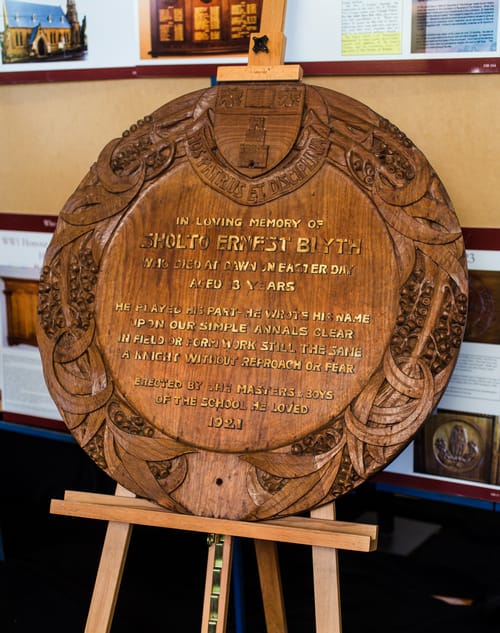Chair and framed photograph, Felsted School, Essex, England. Carved 1912.
DB64
Examiner (Launceston, Tas. : 1900 – 1954), Monday 22 August 1921, page 4
SCHOOL MEMORIAL.
At an evening service held for the boys of this Church Grammar School last night a beautifully carved tablet to the memory of S. E. Blyth, son of Sir. E. F. Blyth, M.H.A., was unveiled by the headmaster (Rev. J. W. Bethune, M.L.A.), who spoke to the boys of the good example and stainless record left behind by the little lad whose memory they were honouring by the memorial they had erected. The tablet is a beautiful piece of work executed by Mrs.C. Payne, of Hobart, whose carving is deservedly admired. The design is a wreath of gum leaves, and at the top of the memorial is the school coat of arms and motto, In the centre, in letters of gold, are the following words:-“In loving memory of Sholto Ernest Blyth who died at dawn on Easter Day, aged 13 years. He played his part, he wrote his name upon our simple annuls clear; in field or form work still the same, a knight without reproach or fear. Erected by the masters and boys of the school he loved. 1921.”
Page 71 “Ellen Nora Payne – Woodcarver of Tasmania” by Russell Atkinson
‘……..in 1921 – a promising and popular boy named Sholto Ernest Blyth had died of an illness while a boarder at the Launceston Church Grammar School. The masters and boys were anxious to erect a fitting memorial to him, and they turned to Mrs. Payne, who designed and carved a plaque, which was duly unveiled by the Headmaster [the Rev. J. W. Bethune] on August 21, 1921.
The design was appropriately simple – intertwined gumleaves and berries enclosing a legend stating that Sholto had ‘died at dawn on Easter Day, aged 13 years’, followed by the verse
He played his part, he wrote his name,
Upon our simple annals clear.
In field or form work still the same,
A knight without reproach or fear.
Erected by the masters and boys of the school he loved.
In its form and detail this plaque was a modification of one that Mrs. Payne had carved in 1918 for the Church of St. John the Baptist at Ouse……’
